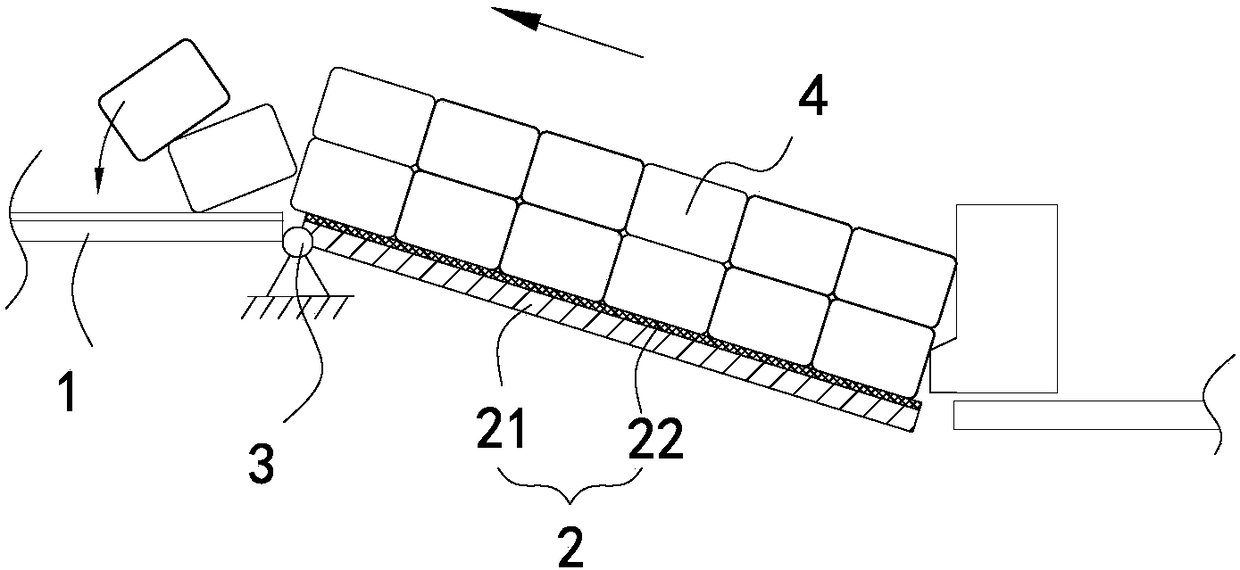Full automatic mahjong machine
A mahjong machine, fully automatic technology, applied in sports accessories, indoor games, etc., can solve problems such as uneven stacking, uneven force on mahjong tiles, overturning, etc.
- Summary
- Abstract
- Description
- Claims
- Application Information
AI Technical Summary
Problems solved by technology
Method used
Image
Examples
Embodiment 1
[0031] To solve this problem, such as Figure 2 to Figure 4 Shown, the structure diagram of the card-raising mechanism part of the fully automatic mahjong machine of the present embodiment is shown, and in the present embodiment, the automatic mahjong includes a card-raising board 2 and a driver, and the card-raising board 2 is relative to the driver under the action of the driver. The tabletop plate 1 of the mahjong machine rotates, and the tabletop plate 1 is provided with a card outlet. In the state of raising the card, the card-raising plate 2 is rotated downwards, and the card outlet is opened, and the downward rotation of the card-raising plate 2 can be driven by a driver. Realization, also can rely on the gravity of the card-raising board 2 itself to sway, when the card-raising board 2 is rotated downward, part of the mahjong tiles 4 are pushed on the table top board 1 obliquely along the card-raising board 2, and the structure of the driver The driver in the existing t...
Embodiment 2
[0040] like Figure 5 As shown, the difference between this embodiment and Embodiment 1 is that the card guide surface 203 in this embodiment is not the top surface of the main body 21, and the main body 21 has no groove 211 in this embodiment. In this embodiment, the patch 22 is attached to the top surface of the main body 21 , and a first distance H1 is left between the rear end of the patch 22 and the rear end of the main body 21 . A second spacing is left, and a patch 23 is arranged in the first spacing H1. The patch 23 is attached to the body 21. The top surface of the patch 23 forms a guide surface 203. The patch 23 can also be a metal plate or a hard plate. The thickness of the patch 23 is basically the same as the thickness of the patch 22 in this embodiment. Likewise, the ends of the patch 22 may be chamfered or beveled.
[0041] In the second interval, a patch 23 is also provided, and the patch 23 is also attached to the top surface of the main body 21 to form the ...
Embodiment 3
[0044] like Image 6 As shown, the difference between this embodiment and Embodiment 1 is that in this embodiment, the main body 21 is not provided with a groove 211, and the patch 22 is directly attached to the main body 21 and does not extend to the rear end 201 of the main body 21. The top surface of the covered part of the body 21 is used as the card guide surface 203 .
[0045] Similarly, the front end of the patch 22 can be selected to extend to the front end 202 of the main body 21, or not to extend to the front end of the main body 21, and a transition surface 205 is reserved. Image 6 Shown in is that the front end of the patch 22 extends to the front end 202 of the body 21 .
PUM
| Property | Measurement | Unit |
|---|---|---|
| Length | aaaaa | aaaaa |
Abstract
Description
Claims
Application Information
 Login to View More
Login to View More - Generate Ideas
- Intellectual Property
- Life Sciences
- Materials
- Tech Scout
- Unparalleled Data Quality
- Higher Quality Content
- 60% Fewer Hallucinations
Browse by: Latest US Patents, China's latest patents, Technical Efficacy Thesaurus, Application Domain, Technology Topic, Popular Technical Reports.
© 2025 PatSnap. All rights reserved.Legal|Privacy policy|Modern Slavery Act Transparency Statement|Sitemap|About US| Contact US: help@patsnap.com



